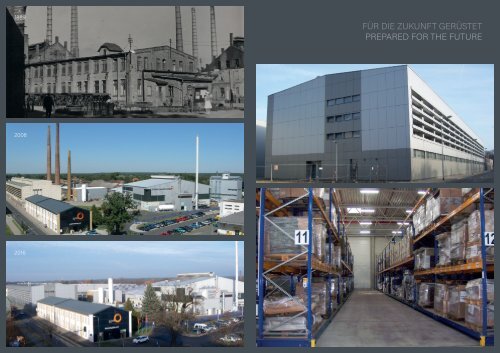You also want an ePaper? Increase the reach of your titles
YUMPU automatically turns print PDFs into web optimized ePapers that Google loves.
GESCHICHTE · HISTORY<br />
Seit über 570 Jahren wird in der Lausitz aufgrund der reichen und qualitativ hochwertigen Rohstoffe<br />
wie Sand und Kalkstein die Kunst der Glasherstellung und –veredelung gepflegt und entwickelt.<br />
Besonders die Glasindustrie konnte sich aufgrund der reichlich vorhandenen Rohstoffe hier entwickeln.<br />
Bis 1900 wurden 67 Glashütten gegründet, was zu einer in der Welt einmaligen Konzentration<br />
von Betrieben für Hohlglasproduktion führte.<br />
1889<br />
Am heutigen Standort der Stölzle Lausitz GmbH, beim Unternehmen „Oberlausitzer Glaswerke J. Schweig<br />
und Co.“ wird das erste Glas geschmolzen<br />
1908<br />
Aufnahme der Kelchglasproduktion<br />
ab 1935<br />
Bauhauspionier Prof. Wilhelm Wagenfeld beeinflusste die Produktentwicklung entscheidend hinsichtlich<br />
Design und Qualität, die auch heute noch Bestand haben<br />
1960er<br />
Erste maschinelle Becherfertigung<br />
1968/1969<br />
Erste maschinelle Stielglasproduktion, Gründung des Kombinats „Lausitzer Glas“; die „Lausitzer Glaswerke<br />
Weißwasser“ werden Stammbetrieb<br />
bis 1991<br />
die Lausitzer Glaswerke sind größter Glasproduzent in der ehemaligen DDR mit rund 4000 Mitarbeitern<br />
1992<br />
Privatisierung der Lausitzer Glaswerke<br />
1996<br />
Übernahme durch die Stölzle-Oberglas AG, Mutterkonzern ist die CAG Holding GmbH/Österreich<br />
Bau und Umbau der Produktionshalle, der drei Produktionslinien und der zwei Glaswannen für die Herstellung<br />
maschinell gefertigter und bleifreier Trinkgläser<br />
2010<br />
Bau und Inbetriebnahme der vierten Produktionslinie (gefördert mit Mitteln des Europäischen Fonds für Regionale Entwicklung<br />
(EFRE))<br />
2016<br />
nach umfangreichem Um- und Neubau Inbetriebnahme der neuen Lager- und Logistikeinheiten<br />
The availability in both quantity and quality of glass sand, wood, lime stone and clay favoured the<br />
development of the first local glassworks in the Lausitz over 570 years ago. But only with the beginning<br />
of the industrialization in 19th century the industrial expansion started in the Lausitz as well. Until 1900<br />
the foundation of 67 glassworks in the region led to a worldwide unique concentration of production<br />
sites for hollow glass products.<br />
1889<br />
First glass production in old hand production site of Stölzle Lausitz GmbH (former company: 'Oberlausitzer<br />
Glaswerke J. Schweig und Co.')<br />
1908<br />
First production of mouth-blown stems<br />
since 1935<br />
Product development regarding design and quality is decisively influenced by ‘Bauhaus’-Pioneer Prof. Wilhelm<br />
Wagenfeld<br />
1960er<br />
First mechanical production of tumblers<br />
1968/1969<br />
First machine-made stemware, establishment of 'Lausitzer Glas'; parent company: 'Lausitzer Glaswerke Weißwasser'<br />
until 1991<br />
Lausitzer Glaswerke is the largest glass producer in former GDR with around 4,000 employees<br />
1992<br />
Privatisation of the ‘Lausitzer Glaswerke’<br />
1996<br />
Take-over by the 'Stölzle-Oberglas AG', Wien/Austria; parent company: CAG Holding GmbH/ Austria<br />
Construction & reconstruction of the production hall, of the three production lines and the two furnaces for the<br />
production of machine-made and lead-free drinking-glasses<br />
2010<br />
Construction and commissioning of the fourth production line (supported by the European Regional Development Fund<br />
(ERDF))<br />
2016<br />
After an extensive reconstruction and new building commissioning of new warehouse and logistics units

















